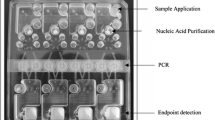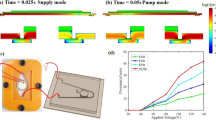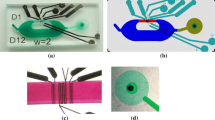Abstract
‘Lab-on-a-chip’ is integrated micro-analytical system, which could perform sample pre-treatment, chemical reactions, analytical separation, detection and data handling. These platforms are able to convert biological, chemical or mechanical responses into electrical signals using the piezoelectric or piezoresistive materials. This paper discusses a piezoelectric composite material displaying its mechanical properties such as resonant frequencies, Young’s modulus and density. Nano composite polymer highlights the property of piezo effect and is suitable for formation of periodic micro scale patterns on it. These micro patterns are intended to be used as innovative functional elements in biomedical micro hydro mechanical systems such as micro channels. Thus by controlling surface configuration and the shape of active deformable polymer, pressure in microfluidic vessels can be changed and mobility of the transported bioparticles can be ensured.
Access provided by CONRICYT-eBooks. Download conference paper PDF
Similar content being viewed by others
Keywords
1 Introduction
Miniaturization of analytical instruments utilizing microfabrication technology has increased the broad usage of analytical chemistry. Main focus was an increasing demand for low-cost instruments able to analyze compounds of very small volume with a high level of automation and precision. The terms ‘Micro-Total Analysis Systems (µ-TAS)’, and also ‘Lab-on-a-chip’, aims to develop integrated micro-analytical systems [1], which could complete analysis cycles (e.g. sample pre-treatment, chemical reactions, analytical separation, detection, and data handling) on the same micro device [2]. In addition to multi-functional abilities, micro fabricated analytical systems should enhance performance, like fast response and increased analysis speed [3].
One of the recent new applications in this area is related to bio sensing elements based on cantilever or membrane type sensing platforms. These platforms are able to convert biological responses into electrical signals [4] using the piezo effect created by the piezoelectric material, on which the active element of the system is based.
Many various materials are used as an active element in the sensing platforms, whether it is a micro-pump, a biosensor or a drug delivery device. PDMS (Polydimethylsiloxane) [5, 6], PU (Polyurethane) [5], PZT (Lead zirconate titanate) [7], Si (Silicon) [8], and SiO (Silicon oxide) [9] have shown a great promise, but all of them lack of flexibility and abilities to change their parameters on-demand. To increase the sensitivity and ability to change parameters of the material a high Q factor is needed [10]. This paper discusses a piezoelectric composite material displaying its mechanical properties such as resonant frequencies, Young’s modulus and density. Nano composite polymer highlights the property of piezo effect and is suitable for formation of periodic micro scale patterns on it. These micro patterns are intended to be used as innovative functional elements in biomedical micro hydro mechanical systems such as micro channels. Thus by controlling surface configuration and the shape of active deformable polymer, pressure in microfluidic vessels can be changed and mobility of the transported bioparticles can be ensured.
2 Experimental Setup
2.1 Piezocomposite Synthesis
Piezocomposite material used in experiments was created using PZT nanopowder and three different binding polymers: polyvinyl butyral (PVB), polymethyl methacrylate (PMMA) and polystyrene (PS). 80% of PZT nanopowder was mixed with solution of polymer in benzyl alcohol under defined conditions: 80% of PZT and 20% of binding material [11]. Thus, three coatings of different thickness were screen printed and investigated: element 1 with a PZT + PVB coating of 50 µm thickness, element 2 with PZT + PMMA coating of 60 µm thickness, and element 3 with PZT + PS coating of 60 µm thickness. More details about the synthesis of piezocomposite are presented in paper [11]. Afterwards, a laminar microstructure of 4 µm period could be embedded into formed piezoelectric film using the thermal embossing technology. Moreover, it is possible to increase optical parameters (surface Plasmon resonance) and ensure antibacterial properties of the formed microstructures using silver nanoparticles. Silver nanoparticles were formed from the solution of 0.05 AgNO3 in deionized water and dip-coated on top of the periodic microstructure [12].
2.2 Mechanical Material Properties
The properties of the binding materials are presented in Table 1. Using these properties, the density of every used composite material was calculated. The density of PZT + PVB, PZT + PMMA, and PZT + PS were 6294 kg/m3, 6314 kg/m3, and 6290 kg/m3 respectively.
The bottom layer of multilayer structure is a copper foil made from UNS C10100 copper alloy. Mechanical properties of used copper alloy are presented in Table 2.
2.3 Multilayer Structure
A cantilever type multilayer elements were created. The proposed element consisted of two layers: copper foil and composite piezoelectric material. Geometrical representation of multilayer structures is presented in Fig. 1.
Geometrical dimensions of these three elements are given in Table 3.
2.4 Dynamic Investigation of Composite Piezoelectric Material
Damping ratio and modulus of elasticity of the piezocomposite materials were determined using hybrid experimental-numerical method. Dynamical response of the multilayer cantilever in to impulse excitation were measured using laser triangular displacement sensor LK-G3000 series together with sensor head of LK-G82 and control block LK-G3001PV made by Keyence from Illinois, US. Signal from control block and the generated voltage were collected with data acquisition system, a 4 channel USB oscilloscope PICO 3424, and forwarded to a computer. Obtained data was then analyzed with Picoscope 6 software. Experimental setup scheme used to measure dynamic characteristics of piezoelectric elements is presented in Fig. 2.
2.5 Theoretical Calculations
In order to compare the experimental and theoretical models, the natural frequency of proposed multilayer specimen had to be calculated by the following formulas 1–3. Logarithmic decrement \( \delta \) from experimental data for n observed periods was calculated according to formula:
where, \( x\left( t \right) \) – amplitude at time \( t \) and \( x\left( {t + nT} \right) \) – amplitude at time \( t + nT \) (after n periods). Then damping ration \( \xi \) was calculated from formula:
Finally the natural frequency \( \omega_{n} \) of the multilayer structure was calculated according to formula:
where \( \omega_{d} \) – the damped natural frequency calculated from experimental data.
3 Results and Discussion
Measured response of multilayer structure with PVB binding materials into pulse excitation is presented in Fig. 3. Measured natural frequency of 31.5 Hz were calculated using formulas 1–3. From numerical simulations natural frequency of 32.1 Hz was determined (Fig. 4) for multilayer construction with PVB binding material, when Young’s modulus is 3.9 GPa. It is only 1.5% difference in natural frequencies. It could be stated that Young’s modulus of PZT + PVB composite material is 3.9 GPa.
The experimentally measured natural frequency of specimen with PS binding material was 43.15 Hz (Fig. 5). The simulation did verify this value as the model gave the result of resonant frequency of 43.02 Hz (Fig. 6) with the accuracy of 0.3% when Young’s modulus of PZT + PS composite material is equal to 5.3 GPa.
The PZT + PMMA composite material has shown the highest Young’s modulus of all three specimens. The value of the Young’s modulus for PMMA is 6.3 GPa. It was also calculated comparing the theoretical (Fig. 8) and experimental (Fig. 7) results of the specimen with PMMA binding material. Theoretical natural frequency was 46.99 Hz and experimental value – 46.17 Hz. Only 1.8% difference has been noted.
The presented material could be used for formation of micro channels with controllable parameters using thermal replication process. Numerically behavior of the system of micro channels of L = 20 μm length, P = 4 μm period, T = 2 μm thickness, d = 1 μm depth, w = 2 μm width of the land and 2r = 2 μm width of the ridge (Fig. 9a) was investigated using COMSOL Multiphysics 5.2a software. It is a periodical system, therefore just one microchannel was analyzed in the model with the symmetrical boundary conditions (Fig. 9b) i.e. left and right surfaces were fixed using rollers. The front and back surfaces were fixed totally because it is attached to fluid containers. The bottom surface will be attached to other components of the sensor, therefore it is totally fixed and it serves as an electrical ground. The top of microchannel system is covered by electrode and rigid transparent layer which allows for the visual inspection of the fluid flow and ensures the high pressure inside of the channel. The system of micro channels is excited by sinusoidal alternating electrical potential of 20 V.
Three examples of the dynamical response of the suggested microchannel are presented in Figs. 10 and 11. The total deformation and X component of the displacement field of the electrically exited system at 110 MHz frequency shows that it works as a mechanical valve i.e. the cross-section area increases or reduces evenly through all the length of microchannel (Fig. 10). While increased frequency to 122 MHz allows to divide channel into two segments with different concentrations of bioparticles (Fig. 11).
An example of bioparticles transportation in microchannel is presented in Fig. 12.
4 Conclusions
New type composite piezoelectric material integrated to an actuator was proposed. Experimental results have shown the natural frequencies of PVB, PMMA, and PS composite piezoelectric material are 32.1 Hz, 46.99 Hz, and 43.15 Hz respectively. Due to a very low difference between theoretical and experimental values (max. deviation of 1.8%) Young’s modulus can be clearly stated for these composite materials. Young’s modulus of PZT mixed with PVB value is 3.9 GPa, PMMA – 6.3 GPa, and PS – 5.3 GPa. A high Q factor of the proposed composite materials would allow to easily control the micro device as micro channels. The ability to change active materials parameters during operation would increase the range of usage and sensing abilities of the system.
References
Burns, M.A., Johnson, B.N., Brahmasandra, S.N., Handique, K., Webster, J.R., Krishnan, M., Sammarco, T.S., Man, F.P., Jones, D., Heldsinger, D., Mastrangelo, C.H., Burke, D.T.: An integrated nanoliter DNA analysis device. Science 282, 484–490 (1998)
Manz, A., Graber, N., Widmer, H.M.: Miniaturized total chemical-analysis systems–a novel concept for chemical sensing. Sens. Actuators B 1, 244–248 (1990)
Jakobson, S.C., Culbertson, C.T., Daler, J.E., Ramsey, J.M.: Microchip structures for submillisecond electrophoresis. Anal. Chem. 70, 3476–3480 (1998)
Ziegler, C.: Cantilever–based biosensors. Anal. Bioanal. Chem. 379, 946–959 (2004)
Arefin, A., Huang, J.H., Platts, D., et al.: Fabrication of flexible thin polyurethane membrane for tissue engineering applications. Biomed. Microdevices 19, 98 (2017)
Holley, M.T., YekrangSafakar, A., Maziveyi, M., et al.: Measurement of cell traction force with a thin film PDMS cantilever. Biomed. Microdevices 19, 97 (2017)
Ogawa, J., Kanno, O., Kotera, H., Wasa, K., Suzuki, T.: Development of liquid pumping devices using vibrating microchannel walls. Sens. Actuators A: Phys. 152, 2 (2009)
Medjahdi, N., Benmoussa, N., Benyoucef, B.: Modeling, simulation and optimization of the mechanical response of micromechanical silicon cantilever: application to piezoresistive force sensor. Phys. Proced. 55, 348–355 (2014)
Stolyarova, S., Cherian, S., Raiteri, R., Zeravik, J., Skladal, P., Nemirovsky, Y.: Composite porous silicon-crystalline silicon cantilevers for enhanced biosensing. Sens. Actuators B Chem. 131, 509–515 (2008)
Lu, J., Ikehara, T., Zhang, Y., Mihara, T., Itoh, T., Maeda, R.: High quality factor silicon cantilever driven by PZT actuator for resonant based mass detection. In: Dans Symposium on Design, Test, Integration and Packaging of MEM/MOEMS – DTIP 2008, Nice, France (2008)
Janusas, G., Ponelyte, S., Brunius, A., Guobiene, A., Vilkauskas, A., Palevicius, A.: Influence of PZT coating thickness and electrical pole alignment on microresonator properties. Sensors 16(11), 1–9 (2016)
Ponelyte, S., Palevicius, A.: Novel piezoelectric effect and surface plasmon resonance-based elements for MEMS applications. Sensors 14, 6910–6921 (2014)
Acknowledgments
This research was funded by a grant S-MIP-17-102 from the Research Council of Lithuania.
Author information
Authors and Affiliations
Corresponding author
Editor information
Editors and Affiliations
Rights and permissions
Copyright information
© 2018 Springer International Publishing AG, part of Springer Nature
About this paper
Cite this paper
Palevicius, A., Janusas, G., Cekas, E., Patel, Y. (2018). Composite Piezoelectric Material for Biomedical Micro Hydraulic System. In: Rojas, I., Ortuño, F. (eds) Bioinformatics and Biomedical Engineering. IWBBIO 2018. Lecture Notes in Computer Science(), vol 10814. Springer, Cham. https://doi.org/10.1007/978-3-319-78759-6_5
Download citation
DOI: https://doi.org/10.1007/978-3-319-78759-6_5
Published:
Publisher Name: Springer, Cham
Print ISBN: 978-3-319-78758-9
Online ISBN: 978-3-319-78759-6
eBook Packages: Computer ScienceComputer Science (R0)
















